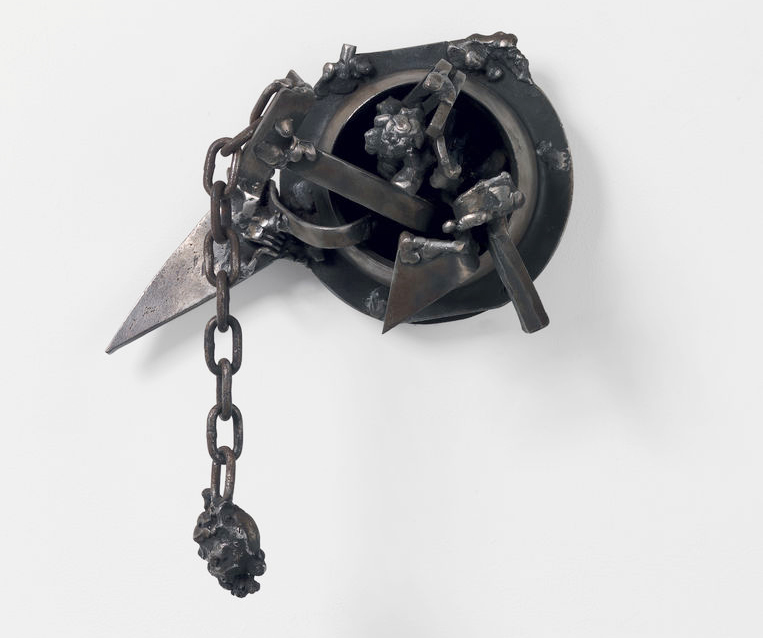
Melvin Edwards, Some Bright Morning, 1963, welded steel, 36 x 23 x 13 cm (The Hammer Museum, Los Angeles; photo: Tim Nighswander/IMAGING4ART) © Melvin Edwards
Nails, chains, and bolts
Displayed on the wall at eye-level, this abstract sculpture appears to change shape from different vantage points. From the front, it looks like a shallow, dense structure of welded pieces of metal. Moving slightly to the right, however, one notices depth: the circular base holds a hollow container that spews out the metal bits. Two sharp triangular shapes, one bigger than the other, jut out of the lower rim of the container like the hands of a clock, both pointing diagonally to the lower left. A bar resembling a lever emerges from the lower right corner, also facing down. The largest bar, when viewed from the right, appears to be a hammer that projects to the upper left. It reaches out the farthest, with a chain fragment attached to its head. Metal chunks mark the welded spots, including a lump at the tip of the dangling chain, and underscore the rugged character of the piece. The shadows, which look different with shifts in the viewer’s position, actively contribute to the appeal of the sculpture by echoing the irregularity of its contour.
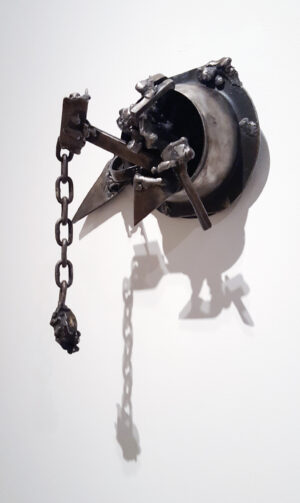
Melvin Edwards, Some Bright Morning, 1963, welded steel, 36 x 23 x 13 cm (The Hammer Museum, Los Angeles; photo: Sunanda K. Sanyal) © Melvin Edwards
The wall-piece, Some Bright Morning, the first in a long series of relief sculptures known as Lynch Fragments, was made by Melvin Edwards in 1963. Edwards was born in Houston in 1937. The Lynch Fragments series began early in his career—in fact while he was a student at the University of Southern California.
Beginning in the 1880s, lynching—the public torture, mutilation, and murder most commonly of a Black person by a white mob for a perceived infraction of southern social codes—became an insidious tool of white supremacy in the American south. Between 1915 and the 1960s, thousands of Black individuals—men, women, and children—were lynched across the southern United States, making it one of the darkest chapters of American history. [1] Edwards’s first-hand experience of racism while growing up in Houston contributed to his acute political awareness and his involvement in the civil rights movement. One case of lynching that deeply affected him was the gruesome murder of Emmett Till in Mississippi in 1955, the year Edwards entered college. Till was four years younger than him, and had been abducted, tortured, and lynched after being accused of offending a white woman.
Around the time Edwards finished the piece described above, he came across a curious phrase in a book called 100 Years of Lynching by Ralph Ginzburg. The author recounted that during the era when incidents of lynching were increasing, African American farm workers in a Florida community who were fighting for their rights received a threat from hostile white locals that they would be attacked on “some bright morning.” Fascinated by this chilling euphemism, Edwards used the phrase to title his first wall-piece and named the ensuing series of relief sculptures “Lynch Fragments.”
The rugged object, with its metal projections strongly evocative of weapons and shrapnel, becomes symbolic not only of the brutality and injustice committed against Black Americans at home and abroad (by 1965, a third of American forces in Vietnam were Black men), but of struggle against oppressive violence anywhere. Its size approximating a human head and its placement at eye-level are deliberate, provoking confrontation with the viewer. The two triangular shapes look ominous, as do the hammer-shaped metal bar pointing upward with the attached chain links. The lumps of metal at the welded spots, especially the chunk at the end of the chain, recall mutilations and wounds; and the shadows enhance the aggressiveness of the object.
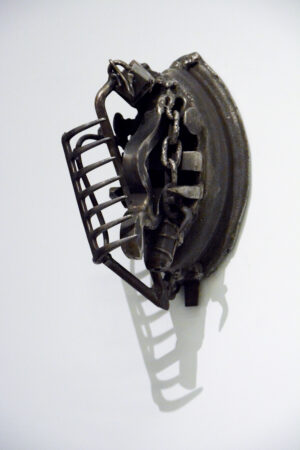
Melvin Edwards, Memory of Winter, 1996, welded steel, 33 x 17 x 22 cm (photo: James Nova, CC BY-NC-ND 2.0) © Melvin Edwards
Edwards continued to make wall pieces with a wide variety of metal components: nails, chains, bolts, locks, rail spikes, scissors, knives, hammers, and farm implements, not to mention scraps extracted from discarded metal objects. The rugged character of the early pieces in the series can be traced to the photographs that the artist took of the destruction caused by the Watts Rebellion in Los Angeles in 1965.
There are more than two hundred sculptures to date in the Lynch Fragments series, produced in three distinct phases. After the first phase (between 1963 and 1966), there was a hiatus of a few years when Edwards left Los Angeles for New York. The works from this phase appeared in his solo exhibition at the Whitney Museum in 1970 (the first solo show for an African American sculptor at that venue). Edwards resumed work on the series in 1973 and made a few more pieces through the following year in response to the Vietnam War. Following another brief pause, he returned to the series in 1978.
As he learned to weld metal, which is how Some Bright Morning is made, Edwards became enchanted by the possibilities of abstraction. The welded sculptures by artists of the early and mid-20th century, such as the Spanish Julio González and the American David Smith, further convinced him to pursue that route. Edwards came to sculpture from rigorous training in drawing and painting and has insisted that welding metal for him is akin to “drawing in the air” (an observation that the critic Clement Greenberg had used to compliment David Smith’s pictorial metal constructions). Despite such affinities, however, he had to be cautious about borrowing from white artists because of the precarious status of artists of color in that era, especially in the context of abstraction.
The materials and ideas of abstraction
At the time Lynch Fragments began, the American art establishment—collectors, dealers, curators, critics—routinely racialized artists of color. Their work was expected to actively address racial identity, yet when it did, the work was often criticized for being confined to a niche, with limited scope. When racial identity was not easily traceable, an artist was deemed unoriginal for venturing into a territory where they supposedly did not belong, such as abstraction. For instance, the Abstract Expressionist painter Edward Clark was consistently ignored by New York’s gallery scene in the 1950s. Artists of color, therefore, frequently found themselves in a double bind, running the risk of either being patronizingly pigeonholed as a Black artist or marginalized altogether.
For Edwards, then, pursuing abstraction was walking a tightrope. Borrowing the gestural freedom from Abstract Expressionism (for example Jackson Pollock) and the use of industrial materials from Minimalism (for example Donald Judd), Edwards rejected their resistance to addressing socially grounded subjects. He wanted his abstract sculpture to allude to life; but because abstract art with social content went against the grain of abstraction in the 1960s, he had to be strategic in connecting materials with ideas.
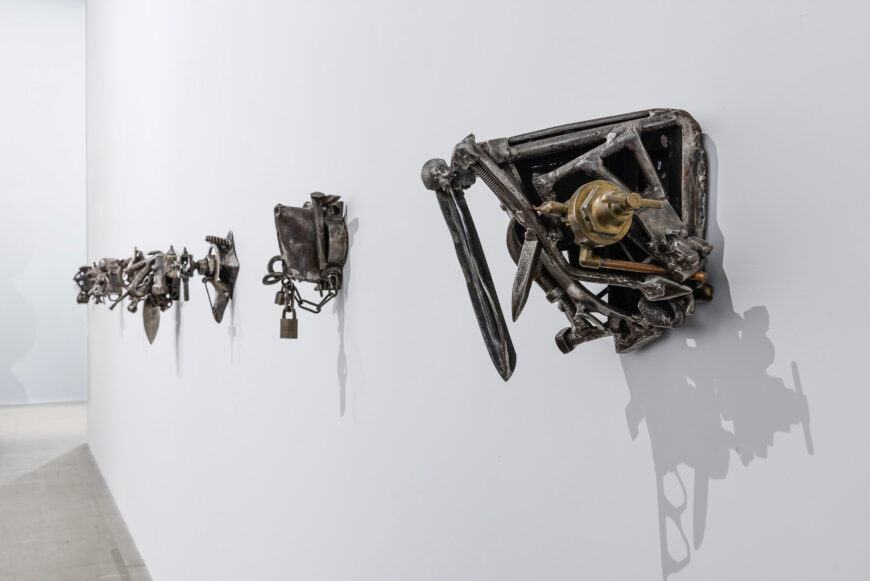
Melvin Edwards, Lynch Fragments (installation view), 1964–2012, welded steel (installed at la Biennale di Venezia, 2015; photo: Andrea Avezzù) © Melvin Edwards
After his first visit to the African continent in 1970, Edwards gradually developed contacts and friendships in several countries there and has maintained a studio in Dakar, Senegal since 2000. This international involvement has enriched his understanding of human history, progress, and identity, enabling him to be much more thoughtful about the objects used later in the series. He sees the chain, for instance, not simply as a symbol of oppression and struggle but also as a much stronger version of rope invented for greater efficiency that can stand for continuity and lineage. Likewise, the machete, a common object in Africa and its diaspora, can be both a weapon of genocide and a benign farming implement. The broader interpretive scope of these items demonstrates that while maintaining the title of the series as a reminder of the trauma that informs his racial identity, the artist has widened the reach of the series Lynch Fragments.
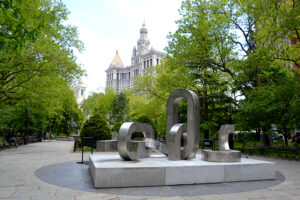
Melvin Edwards, Song of the Broken Chains, 2020, stainless steel (installed at City Hall Park, NYC by Public Art Fund, photo: Trish Mayo) © Melvin Edwards
Melvin Edwards began making large-scale outdoor sculptures in 1968 and worked on commissions alongside his more personal engagement with Lynch Fragments. His latest public piece is Song of the Broken Chains, completed in 2020. Five enormous broken chain links made of stainless steel are juxtaposed with two unbroken ones, one upright and the other horizontal.
While this monumental work appears radically different from the wall-pieces of Lynch Fragments, it is nonetheless tied to the series. Here the journey of the chain fragment that began with Some Bright Morning more than half a century ago reaches a juncture, where a mature American artist of color makes a gesture of peace with the nation’s racial past. The scintillating surface of the sculpture exudes optimism, albeit with a stark reminder of the history of trauma it leaves behind.




